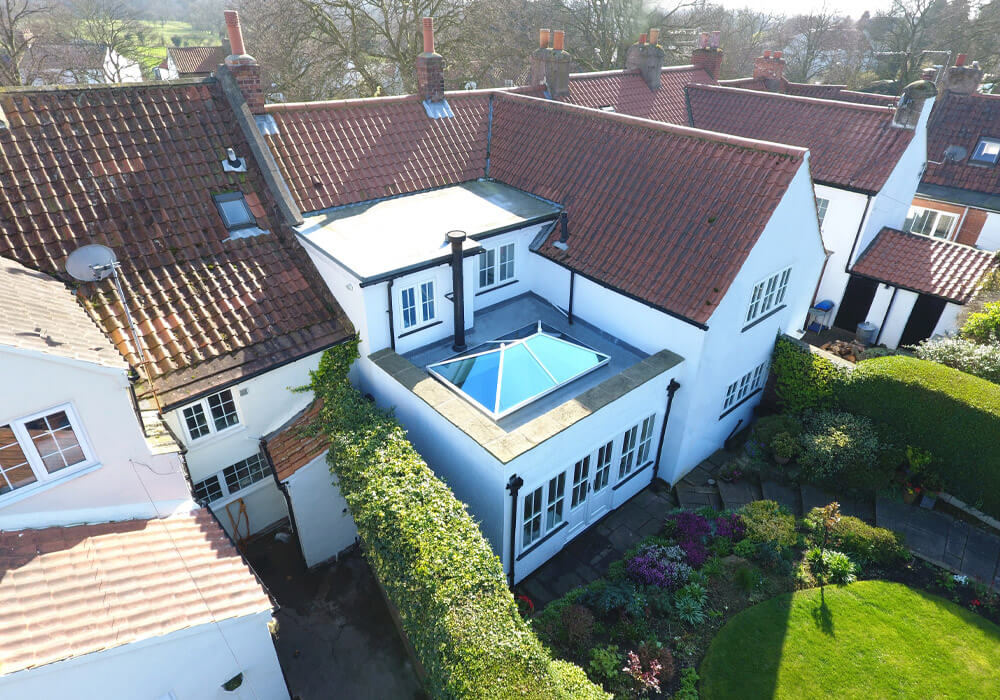There was a time when a chilly conservatory would be largely out of bounds for the winter months and, if it was occupied at all, it was usually heated by portable plug-in devices costing a fortune to run.
In those days, people would look up at their conservatory roof and think, ‘That’s where the heat is escaping…’ And they’d probably be right. Thirty-plus years ago, glazing was nowhere near as energy-efficient as it is today.
Unfortunately, there is still the idea that roof lanterns are a prime source of energy loss. Not so. Huge improvements in glass technology mean that lanterns allow plenty of natural light to fill your space, but have the same thermal performance as any other double or tripled-glazed windows in your home.
How efficient are roof lanterns?
So let’s have a closer look at the technology. For example, our REAL glazed roof has an overall U value of 0.7 w/m2k when tripled-glazed. This means that 0.7 watts of energy will pass through a 1m2 area of a substance for each degree of temperature difference from one side to the other, i.e. heat passing through a sealed unit. The lower the U-value, the better the window performs in terms of insulation, which is why our products frequently outperform many of their rivals.
If you fit a double or triple-glazed rooflight with low U-values, you’re going to let little to no heat out – but you are going to allow extra heat in via the sun’s rays. The warmth coming into your conservatory or extension means that you will use far less central heating, saving you money in the long run and filling the room with natural warmth.
Of course, this is 100 per cent dependent on the type and quality of glass that you choose, and at AIM Windows you’re in the very best of hands. Have a look at our range of roof lantern options and don’t hesitate to get in touch if you need further help or advice.
Let there be warmth and light
As well as creating and retaining warmth, our roof lanterns have another significant environmental benefit – the amount of light they allow into your living space. Quite simply, lanterns allow more light to flood the room, therefore reducing the need to turn on electric lights. At a time when energy bills are going ever skywards, having such windows fitted into the roof means significant savings, given that such windows can allow three times as much light into a room than a wall-fitted window.
It goes without saying that our entire range of roof lanterns is stylish, well-engineered and environmentally excellent, giving plenty of flexibility to suit every London home. Our Skypod is designed for smaller, flat-roofed spaces in need of extra height and light. The aluminium Korniche roof lantern is more suitable for the more traditional home, while roof lights and lanterns from the Atlas range offer some of the slimmest sightlines around. Designed to boost character and warmth, each of our roof lanterns are engineered and tested to offer a lasting barrier against the harshest weather conditions.
Do you need planning permission for a roof lantern?
It depends on the size, location, and other factors. Generally speaking, in the UK, if the roof lantern has an area that does not exceed 3 square metres, then it does not require planning permission.
However, if the roof lantern exceeds 3 square metres, then planning permission may be required. Other factors that could require permission include the height of the roof lantern and its proximity to a road or highway. It is always best to check with your local council before making any changes to your roof to determine whether you need planning permission for a roof lantern or get in touch and we can discuss your options in more detail.
Are roof lanterns noisy in rain?
It depends on the type of roof lantern you have. Some types of roof lanterns are designed to be soundproof and insulated, which can help reduce noise from rain and other weather conditions. Other types may not have these features, so rain may create more noise if it is hitting the roof directly. Our roof lanterns feature the highest quality weatherproofing and high-performance glazing to provide maximum performance all year round.
If you are concerned about noise from rain or other weather conditions, it is worth investigating different types of roof lanterns to find one that is best suited for your needs. Additionally, proper installation of the roof lantern can help reduce any noise from rain by ensuring that it is securely sealed and that there are no gaps or cracks in the construction.
Can you add a roof lantern to an existing roof?
It is possible to add a roof lantern to an existing roof, but it will depend on the type of roof and the size of the roof lantern you want to install – they usually work best on a flat roof.
colourThe roof structure will need to be assessed by a professional installer to determine if it is suitable for a roof lantern. If the existing roof structure is strong enough, then additional support may need to be added in order for the roof lantern to be installed safely and securely.
The installer will also need to take into account any necessary insulation, ventilation, and waterproofing that may be required prior to installation. With careful planning and preparation, it is possible to install a roof lantern on an existing roof.
Contact us for more info
For help choosing which style of roof lantern is right for you, check out our blog post: WHICH TYPE OF ROOF LANTERN IS RIGHT FOR MY HOME?
For more information about our range, contact us or call 0207 537 0852 and we’ll be happy to help.



